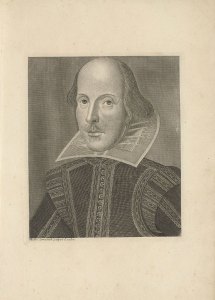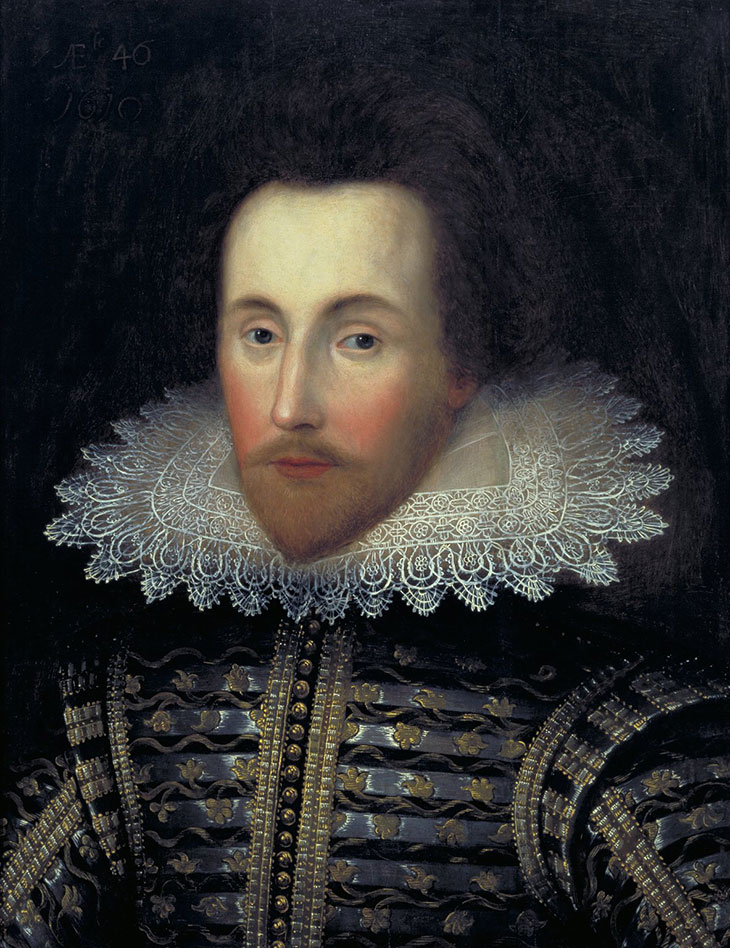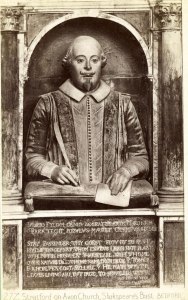What did Shakespeare look like? For centuries, debates have raged over various images supposed to represent the world’s most famous playwright. Now, new evidence uncovered by Lena Cowen Orlin, professor of English at Georgetown University, Washington, D.C, promises to resolve this mystery, pointing to the effigy of Shakespeare in Holy Trinity Church, Stratford-upon-Avon. Depicting a round-faced, balding man in an Oxford undergraduate gown, the half-length sculpture has never elicited much enthusiasm from scholars. (The 20th-century critic J. Dover Wilson memorably described it as resembling a ‘self-satisfied pork butcher’.) Yet Orlin argues that ‘It is very likely that Shakespeare commissioned the monument. It was done by someone who knew him and had seen him in life’. According to her research, as reported last week in the Guardian, the monument was likely made by Nicholas Johnson, a tomb-maker whose workshop was very close to the Globe in Southwark. If the bust was modelled from life – rather than after Shakespeare’s death, as previously thought – it can claim to be the most accurate depiction of the playwright in existence.

Portrait of William Shakespeare (1623–39), Martin Droeshout. Rijksmuseum, Amsterdam
Orlin will present her findings at this year’s Shakespeare Birthday Lecture on 23 April, and in a subsequent monograph. But, although there are no other confirmed portraits of the playwright from life, Orlin is far from the first to claim to have discovered an accurate depiction of Shakespeare. Looking back over the past four centuries, we can trace something of the history of ‘bardolatry’ by examining debates over the playwright’s image. Seven years after Shakespeare’s death in 1616, an engraving by Martin Droeshout was included in the 1623 collection of his plays now known as the ‘First Folio’. In a prefatory poem ‘To the Reader’, Ben Jonson praises the engraver for capturing the late bard’s face – making this the only known likeness to have been ‘verified’ by one of Shakespeare’s contemporaries. Many others, however, have been displeased with this oversized head that seems to float above its body, and have sought out more satisfying representations of their literary hero.
The painting with the strongest claim to authenticity, the ‘Chandos’ portrait depicting a dark-haired man with a golden earring, was given to the National Portrait Gallery on its foundation in 1856. Listed as the very first work in the gallery’s collection, this portrait tells us much about the centrality of Shakespeare in the nation’s self-image. Yet, according to the scholar Katherine Duncan-Jones, at least 60 paintings in collections both private and public have been claimed as life portraits of Shakespeare over the centuries since his death. Some purportedly Jacobean works, such as the ‘Janssen’ portrait, were retrospectively altered to conform more closely with the balding figure in the Folio, while others, such as the ‘Flower’ portrait, are now known to be 19th-century forgeries. A few years ago, much fanfare greeted claims that an early 17th-century painting known as the ‘Cobbe’ portrait is an authentic depiction of the playwright. An image of a handsome, glamorous gentleman with a superbly ornate lace collar, the portrait is undoubtedly better suited to the author of Romeo and Juliet than the dumpy, middle-aged figure on the wall of Holy Trinity Church. However, scholarly consensus maintains that the portrait depicts Sir Thomas Overbury, a far more elite man than the playwright from Stratford.

The Janssen portrait (early 1610s; altered before 1770), unknown artist. Folger Shakespeare Library, Washington, D.C. (CC BY-SA 4.0)
Undoubtedly, debates about the authenticity of such images reflect wider cultural fantasies about the man behind the works. Search ‘Shakespeare’ in Google Images and the decidedly unglamorous Stratford monument is hardly to be seen. Yet Orlin’s evidence of Shakespeare’s personal involvement in his own funerary monument has important implications for our understanding of the writer as a historical figure. She notes that ‘We can think of it as a kind of life portrait, a design for death that gives evidence of a life of learning and literature’. The style of the monument – featuring a cushion, paper, and quill in hand – was typically used to memorialise those with pretensions to learning, indicating that Shakespeare wished to represent himself as a scholarly man of letters, rather than a busy actor-playwright. (This despite, or perhaps because of, the fact that Shakespeare never went to university.) Thus Orlin’s findings are in line with recent reappraisals of Shakespeare’s own investment in his public image as a literary dramatist. While Shakespeare was long thought to be a man of the theatre, uninterested in the publication of his works, recent scholars have presented him as instrumental in shaping his literary reputation among his contemporaries, and for posterity.

The effigy of Shakespeare at Holy Trinity Church, Stratford-upon-Avon, photographed in c. 1885. Courtesy Shakespeare Birthplace Trust
Yet Shakespeare was also acute about the challenges of self-memorialisation. In the Sonnets, he broods over the transience of ‘gilded monuments’ that can all too quickly become ‘unswept stone besmeared with sluttish time’. As Shakespeare knew well, each age reconstructs the past – or forgets it – in accordance with its own needs and desires. Despite Orlin’s discoveries, then, perhaps a range of fluctuating images more powerfully evokes our understanding of Shakespeare than a single authoritative effigy. Coleridge famously described the playwright as ‘our myriad-minded Shakespeare’: his visual elusiveness reflects something of his chameleon-like place in our cultural imagination, continually reinvented according to the sensibility of the age.
The Stratford monument’s various transformations since Shakespeare’s lifetime should also temper the excitement of even the most enthusiastic bardolator. In 1793, the Shakespeare scholar Edmond Malone persuaded the vicar of Holy Trinity Church to have the effigy painted entirely white, in line with the neoclassical taste of the period. The white paint was removed in 1861, and the effigy was repainted in an effort to restore the earlier colours. Perhaps any single image can only tell us so much about a writer renowned for his boundless verbal inventiveness, and whose works evince a profound understanding of the contingencies of cultural memory. Ben Jonson’s advice to the reader of the First Folio is clear: ‘Reader, looke / Not on his Picture, but his Booke’.

Is this what Shakespeare really looked like?
Will the real William Shakespeare please stand up? The effigy above the playwright’s grave in Holy Trinity Church, Stratford-upon-Avon. Colin Underhill/Alamy Stock Photo
Share
What did Shakespeare look like? For centuries, debates have raged over various images supposed to represent the world’s most famous playwright. Now, new evidence uncovered by Lena Cowen Orlin, professor of English at Georgetown University, Washington, D.C, promises to resolve this mystery, pointing to the effigy of Shakespeare in Holy Trinity Church, Stratford-upon-Avon. Depicting a round-faced, balding man in an Oxford undergraduate gown, the half-length sculpture has never elicited much enthusiasm from scholars. (The 20th-century critic J. Dover Wilson memorably described it as resembling a ‘self-satisfied pork butcher’.) Yet Orlin argues that ‘It is very likely that Shakespeare commissioned the monument. It was done by someone who knew him and had seen him in life’. According to her research, as reported last week in the Guardian, the monument was likely made by Nicholas Johnson, a tomb-maker whose workshop was very close to the Globe in Southwark. If the bust was modelled from life – rather than after Shakespeare’s death, as previously thought – it can claim to be the most accurate depiction of the playwright in existence.
Portrait of William Shakespeare (1623–39), Martin Droeshout. Rijksmuseum, Amsterdam
Orlin will present her findings at this year’s Shakespeare Birthday Lecture on 23 April, and in a subsequent monograph. But, although there are no other confirmed portraits of the playwright from life, Orlin is far from the first to claim to have discovered an accurate depiction of Shakespeare. Looking back over the past four centuries, we can trace something of the history of ‘bardolatry’ by examining debates over the playwright’s image. Seven years after Shakespeare’s death in 1616, an engraving by Martin Droeshout was included in the 1623 collection of his plays now known as the ‘First Folio’. In a prefatory poem ‘To the Reader’, Ben Jonson praises the engraver for capturing the late bard’s face – making this the only known likeness to have been ‘verified’ by one of Shakespeare’s contemporaries. Many others, however, have been displeased with this oversized head that seems to float above its body, and have sought out more satisfying representations of their literary hero.
The painting with the strongest claim to authenticity, the ‘Chandos’ portrait depicting a dark-haired man with a golden earring, was given to the National Portrait Gallery on its foundation in 1856. Listed as the very first work in the gallery’s collection, this portrait tells us much about the centrality of Shakespeare in the nation’s self-image. Yet, according to the scholar Katherine Duncan-Jones, at least 60 paintings in collections both private and public have been claimed as life portraits of Shakespeare over the centuries since his death. Some purportedly Jacobean works, such as the ‘Janssen’ portrait, were retrospectively altered to conform more closely with the balding figure in the Folio, while others, such as the ‘Flower’ portrait, are now known to be 19th-century forgeries. A few years ago, much fanfare greeted claims that an early 17th-century painting known as the ‘Cobbe’ portrait is an authentic depiction of the playwright. An image of a handsome, glamorous gentleman with a superbly ornate lace collar, the portrait is undoubtedly better suited to the author of Romeo and Juliet than the dumpy, middle-aged figure on the wall of Holy Trinity Church. However, scholarly consensus maintains that the portrait depicts Sir Thomas Overbury, a far more elite man than the playwright from Stratford.
The Janssen portrait (early 1610s; altered before 1770), unknown artist. Folger Shakespeare Library, Washington, D.C. (CC BY-SA 4.0)
Undoubtedly, debates about the authenticity of such images reflect wider cultural fantasies about the man behind the works. Search ‘Shakespeare’ in Google Images and the decidedly unglamorous Stratford monument is hardly to be seen. Yet Orlin’s evidence of Shakespeare’s personal involvement in his own funerary monument has important implications for our understanding of the writer as a historical figure. She notes that ‘We can think of it as a kind of life portrait, a design for death that gives evidence of a life of learning and literature’. The style of the monument – featuring a cushion, paper, and quill in hand – was typically used to memorialise those with pretensions to learning, indicating that Shakespeare wished to represent himself as a scholarly man of letters, rather than a busy actor-playwright. (This despite, or perhaps because of, the fact that Shakespeare never went to university.) Thus Orlin’s findings are in line with recent reappraisals of Shakespeare’s own investment in his public image as a literary dramatist. While Shakespeare was long thought to be a man of the theatre, uninterested in the publication of his works, recent scholars have presented him as instrumental in shaping his literary reputation among his contemporaries, and for posterity.
The effigy of Shakespeare at Holy Trinity Church, Stratford-upon-Avon, photographed in c. 1885. Courtesy Shakespeare Birthplace Trust
Yet Shakespeare was also acute about the challenges of self-memorialisation. In the Sonnets, he broods over the transience of ‘gilded monuments’ that can all too quickly become ‘unswept stone besmeared with sluttish time’. As Shakespeare knew well, each age reconstructs the past – or forgets it – in accordance with its own needs and desires. Despite Orlin’s discoveries, then, perhaps a range of fluctuating images more powerfully evokes our understanding of Shakespeare than a single authoritative effigy. Coleridge famously described the playwright as ‘our myriad-minded Shakespeare’: his visual elusiveness reflects something of his chameleon-like place in our cultural imagination, continually reinvented according to the sensibility of the age.
The Stratford monument’s various transformations since Shakespeare’s lifetime should also temper the excitement of even the most enthusiastic bardolator. In 1793, the Shakespeare scholar Edmond Malone persuaded the vicar of Holy Trinity Church to have the effigy painted entirely white, in line with the neoclassical taste of the period. The white paint was removed in 1861, and the effigy was repainted in an effort to restore the earlier colours. Perhaps any single image can only tell us so much about a writer renowned for his boundless verbal inventiveness, and whose works evince a profound understanding of the contingencies of cultural memory. Ben Jonson’s advice to the reader of the First Folio is clear: ‘Reader, looke / Not on his Picture, but his Booke’.
Unlimited access from just $16 every 3 months
Subscribe to get unlimited and exclusive access to the top art stories, interviews and exhibition reviews.
Share
Recommended for you
Bard boy – David Garrick and the cult of Shakespeare
The actor did more than anyone to revive Shakespeare’s reputation in the 18th century – and a plethora of curious wooden relics also played their part
Shakespeare’s First Folio will set you back millions – but its cultural value is immeasurable
A complete version of the first collected edition of Shakespeare’s plays is up for sale. What is it that makes this book so desirable?
Venus enlargement? Marlene Dumas takes on Shakespeare’s erotic verse
The artist is one of few to have attempted to illustrate Venus and Adonis